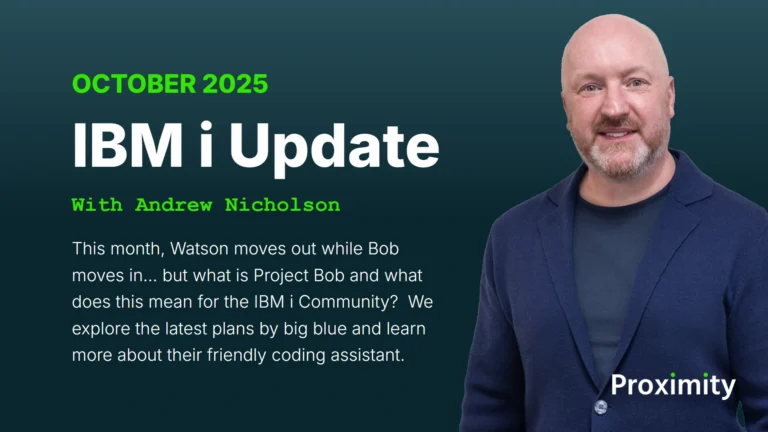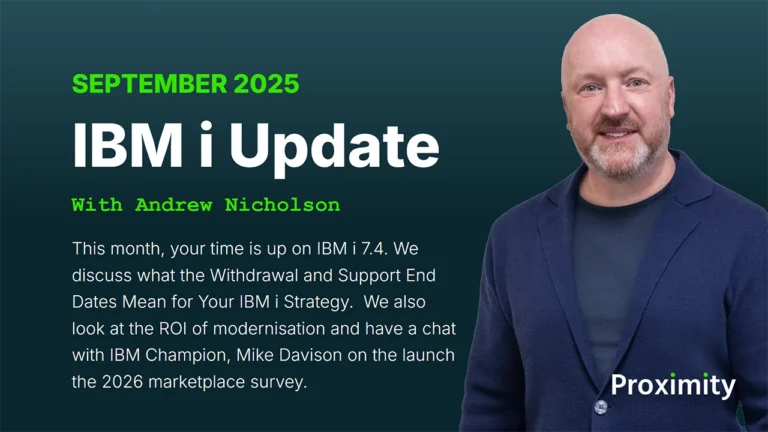In the realm of enterprise computing, IBM i systems have long been a bastion of reliability, robustness and longevity.
However, to remain competitive, modern businesses must evolve their IBM i applications to meet new technological challenges and demands.
The Challenge: Legacy Code and Technical Debt
Many IBM i (AS/400, iSeries) applications have been in production for decades.
Over time, they accumulate technical debt, undocumented code, and hidden dependencies, making modernisation efforts slow and risky. As senior developers retire, businesses face:
- Lack of documentation – Maintenance becomes time-consuming and difficult.
- Hidden dependencies – Small changes can trigger system-wide issues.
- Slow modernisation efforts – Poor visibility into RPG and COBOL applications leads to stalled digital transformation.
- High maintenance costs – Inefficient code increases IT spending
- Risk to Business Continuity – With knowledge retired, any failure may cause significant downtime to the enterprise resulting in expensive shutdown of operations.
Without automated tools, IT teams are left guessing how applications function and interact, making modernisation a risky process.
The need for IBM i application modernisation
IBM i application modernisation is crucial for businesses aiming to use the latest technological innovations while maintaining the integrity of their existing infrastructure.

As we’ve explored in other articles, modernisation of IBM i applications encompasses a range of strategies, including the integration of open-source utilities, modernising interfaces, integrating IBM i application with other back office systems internally and externally – the list goes on.
By employing these strategies, businesses can ensure that their IBM i systems are not just operational but fit for purpose for current and future demands.
Understanding Automated Code Analysis
Automated code analysis involves the use of specialised tools to examine codebases systematically.
For IBM i applications, this may mean scrutinising RPG (Report Program Generator) and COBOL code to identify potential inefficiencies, security vulnerabilities, or outdated practices.
Tools like X-Analysis are vital in the process, providing comprehensive insights into the code structure and functionality.
The strength of automated code analysis lies in its ability to enhance code quality, reduce technical debt, and facilitate smoother transitions during system upgrades or migrations.
Why IBM i applications need automated code analysis
Many IBM i (AS/400, iSeries) applications have been in production for decades.
As senior developers retire, businesses face:
- Lack of documentation: making IBM i application maintenance time-consuming.
- Hidden dependencies: changes to one program can impact multiple others.
- Slow modernisation and development efforts: without clear visibility into legacy RPG and COBOL applications, digital transformation projects stall.
- High maintenance costs: unoptimised code leads to inefficiencies and increased IT spending.
Without IBM i code analysis tools, IT teams can be left guessing how their applications function and their code interacts leading to high risk and uncertainty when making changes.
Using IBM i documentation tools
Documentation is a cornerstone of effective system management. For IBM i systems, robust documentation tools are indispensable.
They provide a clear blueprint of system operations, facilitating better understanding and management of complex IBM i applications.
Tools designed for IBM i code documentation play a critical role here.
They not only help in maintaining up-to-date documentation but also assist in the onboarding of new developers by providing them with a comprehensive understanding of existing systems.
How X-Analysis Transforms IBM i Code Analysis and Documentation
X-Analysis by Fresche Solutions is a powerful IBM i code analysis and documentation tool that helps businesses streamline legacy application management.
It offers a suite of features designed to streamline the analysis process, making it easier for IT managers and developers to uncover hidden complexities within their codebases.
From identifying obsolete code to pinpointing performance bottlenecks, X-Analysis provides a detailed roadmap for maintenance, development and modernisation.
Furthermore, its integration capabilities allow businesses to seamlessly incorporate modern development languages and frameworks into their IBM i applications, ensuring that these systems remain agile and responsive to new demands.
Key Features of X-Analysis for IBM i
- Automated Code Documentation – Analyses RPG, COBOL, and CL programs and from this, creates detailed, structured documentation.
- Business Rule Extraction – Identifies critical logic embedded within IBM i applications, enabling easier modernisation.
- Graphical Code Visualization – Displays application data flows, object dependencies, and impact analysis.
- Cross-Referencing & Impact Analysis – Quickly assesses how code changes will affect the entire system.
- IBM i Cloud Migration Support – Prepares legacy applications for cloud-based IBM i environments.
Future-Proofing IBM i Applications
Future-proofing your IBM i applications is not merely about maintaining functionality; it is about enhancing it.
Automated code analysis is central to this process, offering a clear pathway to optimising existing systems while laying the groundwork for future advancements.
Embracing Modern Development Languages
The integration of modern development languages is a key component of IBM i modernization efforts.
Languages such as Java, PHP, Python, and Ruby can be used alongside traditional RPG and COBOL, allowing for more versatile and dynamic application development.
By using these languages, businesses can unlock new functionalities and improve user experiences, all while maintaining the robust operational backbone provided by IBM i systems.
The Business Impact of X-Analysis
Using X-Analysis for automated IBM i code analysis can help organisations:
- Reduce IBM i maintenance costs by improving code visibility and documentation.
- Accelerate IBM i development & modernisation projects with automated business rule extraction.
- Lower development risks by identifying potential issues before making changes.
- Enable faster onboarding of new developers by providing clear IBM i application insights.
- Support IBM i cloud migration by understanding legacy system architectures.
Conclusion
Future-proofing IBM i applications through automated code analysis is a strategic approach that combines the reliability of legacy systems with the dynamism of modern technologies.
By employing comprehensive code analysis tools like X-Analysis, businesses can enhance code quality, streamline system operations, and ensure that their applications are equipped to meet future challenges.
Ready to automate your IBM i application documentation? Learn more about X-Analysis here.
We have created a video demonstration available on YouTube. It shows how to develop IBM i applications confidently using X-Analysis.





